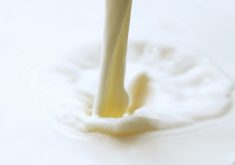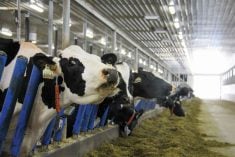Canadian dairy industry output has grown even as the number of dairy farms and processors has declined.
That’s according to a recent study, commissioned by the Dairy Farmers of Canada.
The study, by Montreal-based EcoRessources, looks at changes between 2013 and 2015 and is the latest biannual examination of the sector dating back to 2009.
Wally Smith, president of Dairy Farmers of Canada, says the study demonstrates the economic spinoffs of the dairy industry.
“We take great pride in our industry’s economic contribution – creating jobs, increasing milk production, diversifying dairy products and stimulating local economies,” Smith said. “All of these elements benefit Canadians and Canada.”
Read Also

Seeding Indigenous agricultural prosperity
National Circle for Indigenous Agriculture and Food says Indigenous agricultural success needs strong relationships.
During the latest two-year period, the number of dairy farms dropped by 4.5 per cent to 11,700 while total mile production grew by nearly five per cent to 82 million litres. Quebec has 49.4 per cent of the dairy farms while Ontario has 32.8 per cent.
The number of processing plants fell by 4.5 per cent to 444, mostly in Quebec and Ontario. They shipped $17 billion worth of products in 2015, up 7.3 per cent compared to 2013.
While on-farm employment dropped, employment in the dairy sector reached 221,000 full-time jobs, three per cent higher than in 2013. The industry generated $19.9 billion worth of gross domestic product, five per cent higher than in 2013.
Since 2009, the industry has seen a 26 per cent increase in sales and three per cent rise in jobs. Ontario recorded an 11 per cent increase, mainly because of its share of the processing sector, while Quebec increased 0.9 per cent. Western Canada underwent a 4.7 per cent decrease while the Maritimes were down 10.2 per cent.
The report notes that the dairy industry contributed $3.8 billion in local, provincial and federal taxes and its contribution to the GDP has increased to $19.9B in 2015 from $15.2B in 2009.
Canada’s overall milk production increased 6.71 per cent between 2009 and 2015.
“While Ontario and Quebec have the bulk of milk production, processing and population of Canada, dairy farming remains one of the top two agricultural sectors of importance in seven out of 10 provinces,” the report reads.
The report said dairy production is important to every region of the country, but noted regional differences.
“Ontario stands out primarily for its concentration of dairy processing. As a result, roughly 46 per cent of the impacts from dairy processing are found in this province, compared to 32 per cent of the impacts generated by production. The opposite is found in Quebec, where 40 per cent of the impacts from production are generated, compared to 30 per cent of the impacts from processing. This is primarily due to the concentration of the manufacturing sector and, in particular, the dairy-processing sector in Ontario.
Sales by dairy-processing companies in Ontario reached $7.6 billion in 2015, compared to $5.4 billion in Quebec.
The industry’s GDP growth reached 21 per cent in Western Canada, 49 per cent in Ontario, 22 per cent in Quebec and five per cent in the Maritimes. In terms of tax impacts, the 2009-15 period saw a 35 per cent increase in Western Canada, 36 per cent in Ontario and 13 per cent in Quebec. In the Maritimes, tax revenues generated by the industry dropped by two per cent.















